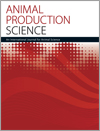
Animal Production Science
Volume 61 Number 4 2021
Understanding how much genetic gain can be made in reducing breech flystrike, while selecting for other key traits is important in choosing breeding objectives for Merino genetic improvement programs in Australia. Results are presented from predictions of genetic gain for reducing breech flystrike incidence under multi-trait selection for a range of different breeding objectives within three different environments, using modified MERINOSELECT indexes.
AN20248 Abstract | AN20248 Full Text | AN20248PDF (2.3 MB) | AN20248Supplementary Material (714 KB) Open Access Article
The effects of the X chromosome on economically important traits of livestock have gained a great deal of attention in recent years. Here, we showed that a small part of the total additive genetic variance in growth and efficiency-related traits of Baluchi sheep during the post-weaning growth phase is caused by activity of loci on the X chromosome. However, these effects were only statistically significant for the efficiency of growth.
AN20498Effects of protein supplementation on Nellore cows’ reproductive performance, growth, myogenesis, lipogenesis and intestine development of the progeny

Nutrient restriction in pregnant beef cows has been an issue for reproduction performance and offspring development. It happens because muscle formation of the fetus from feed-restricted cows may be impaired, resulting in a low number of muscle fibres, which may have a negative impact on cattle growth. In addition, the knowledge of nutrition effects on gene expression is an important tool to understand myogenesis and adipogenesis, which may have effects on long-term performance and meat quality of the offspring.
Being able to measure the amount of feed energy consumed by individual animals is crucial to breeding of more efficient farm animals and the evaluation of alternate pasture species and supplementary feeds. Portable machines now available that sample breath emissions to measure oxygen consumption, carbon dioxide production and methane production, and were used to develop models to determine energy usage by free-ranging cattle. This technology can facilitate development of breeding and feeding strategies to improve animal productivity while reducing greenhouse-gas emissions.
The use of non-antibiotic growth promoters such as probiotics and prebiotics or their combination in poultry nutrition increase production efficiency without endangering consumer health. The previously confirmed prebiotic properties of Spirulina platensis were assessed in combination with a probiotic (Bacillus subtilis PB6) for effects on broiler chicken performance. The experiment showed that the individual use of Spirulina and Bacillus subtilis improves the growth performance and intestinal microbiota of broiler chickens, and their mixture modifies morphometric characteristics of the intestine.
Hydrolysis of animal and plant protein ingredients is interesting way to produce small peptides and free amino acids for human and animal consumption. The present study tested the inclusion in chicken diets of low-weight peptides and free amino acids produced from cow-skin gelatin and found that it did not improve broiler performance. This study points to the need to understand the possible problems with acid hydrolysis and why it negatively affects broiler performance.
Animal welfare and productivity are interrelated. We conducted a study to quantify this relationship, and the results showed that a higher prevalence of indicators related to poor welfare was associated with a worse feed conversion ratio and daily feed intake. Some welfare indicators could be used as predictors of performance, facilitating changes that would improve both animal welfare and farm profitability.
AN20237Provision of straw and the presence of undocked lambs reduce the behavioural and physiological expressions of pain and stress associated with tail docking in lambs: a preliminary study
 , Ana Strappini, Gerardo Acosta-Jamett, Daniel Mota-Rojas and Carmen Gallo
, Ana Strappini, Gerardo Acosta-Jamett, Daniel Mota-Rojas and Carmen Gallo
There is an increased concern for animal welfare worldwide, particularly for domestic animals subjected to painful management practices, such as tail docking in lambs, which is still routinely performed without anaesthesia in many countries. Our study shows that the provision of straw and the presence of undocked lambs reduce the behavioural and physiological expressions of pain associated with tail docking in lambs. These results could be a practical strategy for sheep producers where the use of anaesthesia is not allowed or impractical.
AN20349Collagen, intramuscular fat and proteolysis affect Warner-Bratzler shear-force of muscles from Bos taurus breed types differently at weaning, after backgrounding on pasture, and after feedlotting
 , Paul L. Greenwood
, Paul L. Greenwood  , Colin P. Starkey, Malcolm McPhee
, Colin P. Starkey, Malcolm McPhee  , Brad Walmsley, Jason Siddell and Geert Geesink
, Brad Walmsley, Jason Siddell and Geert Geesink
Meat texture is the main trait that contributes to the eating satisfaction of beef, but there is a large variation in texture of meat. Depending on the age and feeding phase of the animal this variation is dependent on the proteolysis of muscle proteins (young weaned animals) or on the amount of collagen in the meat (older feedlot finished animals). Within muscles, it is the amount of intramuscular fat that contributes most to differences in texture.



